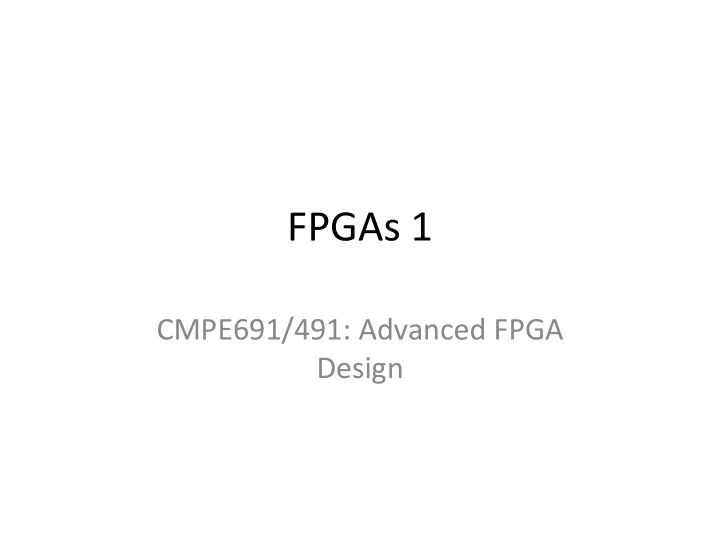

FPGAs 1 CMPE691/491: Advanced FPGA Design
FPGAs Large array of configurable logic blocks (CLB) connected via programmable interconnects
Features and Specifications of FPGAs
Basic Programmable Devices
Features and Specifications of FPGAs
Features and Specifications of FPGAs
Features and Specifications of FPGAs
Generic Xilinx FPGA Architecture
Features and Specifications of FPGAs
Virtex FPGA family name
FPGA vs ASIC
Standard cell based IC vs. Custom design IC Standard cell based IC: Design using standard cells Standard cells come from library provider Many different choices for cell size, delay, leakage power Many EDA tools to automate this flow Shorter design time Custom design IC: Design all by yourself Higher performance
Standard cell based VLSI design flow Front end System specification and architecture HDL coding & behavioral simulation Synthesis & gate level simulation Back end Placement and routing DRC (Design Rule Check), LVS (Layout vs Schematic) dynamic simulation and static analysis
Simple diagram of the front-end design flow System RTL Gate level code Synthesis Specification Coding INV (.in (a), .out (a_inv)); Ex: c = !a & b AND (.in1 (a_inv), .in2 (b), .out (c)); a C b
Simple diagram of the back-end design flow Design rule DRC check Final layout gate level Verilog Place (go for fabrication) from synthesis & Layout vs. Route LVS schematic Gate level Verilog Timing information Gate level dynamic and/or static analysis
Flow of placement and routing • Floorplan (place macros, do power planning) • Placement and in-place optimization • Clock tree generation • Routing
Import needed files • Gate level verilog (.v) • Geometry information (.lef) • Timing information (.lib) INV (.in (a), .out (a_inv)); b AND (.in1 (a_inv), .in2 (b), .out (c)); C a INV: 1um width AND: 2 um width AND INV INV: 1ns delay; AND: 2 ns delay Delay (a->c): 1ns + 2ns = 3ns
Floorplan • Size of chip • Location of Pins • Location of main blocks • Power supply: give enough power for each gate (need another power) Power supply (1.8V) 1.75v 1.7v 1.65v current VDD (Metal) Gate 1 Gate 2 Gate 3 Gate 4 VSS Voltage drop equation: V2 = V1 – I * R
Floorplan of a single processor Inst Mem Clock In- FIFO0 ALU MAC Output Control In- FIFO1 Data Mem
Placement & in-placement optimization • Placement: place the gates • In-placement optimization – Why: timing information difference between synthesis and layout (wire delay) – How: change gate size, insert buffers – Should not change the circuit function!!
Placement of a single processor
Clock tree • Main parameters: skew, delay, transition time Clock Delay= x Clock Skew= x -y SET S Q SET SET R Q S S Q Q CLR R R Q Q CLR CLR Original Clock SET S Q SET SET R Q S S Q Q CLR R R Q Q CLR CLR SET S Q SET SET R Q S S Q Q CLR R R Q Q Clock Delay = y CLR CLR
Clock tree of single processor
Routing • Connect the gates using wires • Two steps – Connect the global signals (power) – Connect other signals
Routing Metal Layer Topology
Layout of a single processor Area: 0.8mm x 0.8mm Estimated speed: 450 MHz
Clock Tree in FPGAs • Everything is preplaced and routed (there is no space for improvement) • There is no gate sizing to enhance performance
FPGA vs ASIC summary • Front-end design flow is almost the same for both • Back-end design flow optimization is different – ASIC design: freedom in routing, gate sizing, power gating and clock tree optimization. – FPGA design: everything is preplaced, clock tree is pre-routed, no power gating – Designs implemented in FPGAs are slower and consume more power than ASIC
FPGA vs DSP
FPGA vs DSP • DSP: – Easy to program (usually standard C) – Very efficient for complex sequential math-intensive tasks – Fixed datapath-width. Ex: 24-bit adder, is not efficient for 5- bit addition – Limited resources • FPGA – Requires HDL language programming – Efficient for highly parallel applications – Efficient for bit-level operations – Large number of gates and resources – Does not support floating point, must construct your own.
Current trend • Programming flexibility Energy efficiency Performance & ASIC • High performance Many – Throughput -core FPGA – Latency • High energy efficiency Prog. DSP • Suitable for future fabrication technologies Programming flexibility
Target Many-core Architecture • High performance • Exploit task-level parallelism in digital signal processing and multimedia – Large number of processors per chip to support multiple applications • High energy efficiency High F, V – Voltage and frequency scaling Low F, V Halt capability per processor 34
167-processor Multi-voltage Computational Chip • 164 programmable procs. • Three dedicated-purpose procs. • Per processor Dynamic Voltage and Frequency Scaling (DVFS) – Selects between two voltages (VDD High and VDD Low) – Programmable local oscillator FFT Motion Estimation Viterbi 16 KB Shared Decoder Memories D. Truong, W. Cheng, T. Mohsenin, Z. Yu, A. Jacobson, G. Landge, M. Meeuwsen, 35 C. Watnik, A. Tran, Z. Xiao, E. Work, J. Webb, P. Mejia, B. Baas, VLSI Symp. 2008, JSSC 2009
Summary of the 167 Many-core Chip Single Tile 55 million transistors, 39.4 mm 2 Transistors 325,000 410 μm Area 0.17 mm 2 CMOS Tech. 65 nm ST Microelectronics 410 μm low-leakage 5.939 mm Max. 1.19 GHz @ frequency 1.3 V Power 59 mW @ (100% 1.19 GHz, 1.3 V active) 47 mW @ 1.06 GHz, 1.2 V Mot. FFT 608 μW @ Mem Mem Est. Mem Vit 66 MHz, 0.675 V 5.516 mm App. power 16 mW @ (802.11a rx) 590 MHz, 1.3 V
Design Flow
Design Flow
Features and Specifications of FPGAs
Features and Specifications of FPGAs
Features and Specifications of FPGAs
Features and Specifications of FPGAs
Features and Specifications of FPGAs
Features and Specifications of FPGAs
Features and Specifications of FPGAs
Backup
Recommend
More recommend